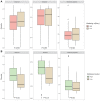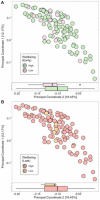Maternal breastfeeding is associated with offspring microbiome diversity; a secondary analysis of the MicrobeMom randomized control trial
- PMID: 37720155
- PMCID: PMC10502216
- DOI: 10.3389/fmicb.2023.1154114
Maternal breastfeeding is associated with offspring microbiome diversity; a secondary analysis of the MicrobeMom randomized control trial
Abstract
Background: Microbial dysbiosis in infancy can influence long-term health outcomes such as childhood obesity. The aim of this study is to explore relationships among maternal well-being during pregnancy, breastfeeding, and the infant gut microbiome.
Methods: This is a secondary analysis of healthy pregnant women from the MicrobeMom study, a double-blind randomized control trial of maternal probiotic supplementation (Bifidobacterium breve 702258) versus placebo antenatally and up to 3 months postpartum. Maternal well-being was assessed using the WHO-5 well-being index at 16 weeks' and 34 weeks' gestation. Breastfeeding practices were recorded at discharge from hospital and at 1 month postpartum. Infant stool samples were obtained at 1 month of age. Next generation shotgun sequencing determined infant microbial diversity. Independent sample t-tests and Mann-Whitney U tests informed adjusted regression analysis, which was adjusted for delivery mode, antibiotics during delivery, maternal age and body mass index (BMI), and probiotic vs. control study group.
Results: Women (n = 118) with at least one measure of well-being were on average 33 years (SD 3.93) of age and 25.09 kg/m2 (SD 3.28) BMI. Exclusive breastfeeding was initiated by 65% (n = 74). Any breastfeeding was continued by 69% (n = 81) after 1 month. In early and late pregnancy, 87% (n = 97/111) and 94% (n = 107/114) had high well-being scores. Well-being was not associated with infant microbial diversity at 1 month. In adjusted analysis, exclusive breastfeeding at discharge from hospital was associated with infant microbial beta diversity (PC2; 0.254, 95% CI 0.006, 0.038). At 1 month postpartum, any breastfeeding was associated with infant microbial alpha diversity (Shannon index; -0.241, 95% CI -0.498, -0.060) and observed species; (-0.325, 95% CI -0.307, -0.060), and infant microbial beta diversity (PC2; 0.319, 95% CI 0.013, 0.045). Exclusive breastfeeding at 1 month postpartum was associated with infant alpha diversity (Shannon index -0.364, 95% CI -0.573, -0.194; Simpson index 0.339, 95% CI 0.027, 0.091), and infant's number of observed microbial species (-0.271, 95% CI -0.172, -0.037).
Conclusion: Breastfeeding practices at 1 month postpartum were associated with lower microbial diversity and observed species in infants at 1 month postpartum, which is potentially beneficial to allow greater abundance of Bifidobacterium.
Clinical trial registration: ISRCTN53023014.
Keywords: breastfeeding; infant health; microbiome; pregnancy; well-being.
Copyright © 2023 Yelverton, Killeen, Feehily, Moore, Callaghan, Geraghty, Byrne, Walsh, Lawton, Murphy, Van Sinderen, Cotter and McAuliffe.
Conflict of interest statement
The author EM was employed by PrecisionBiotics Group Ltd. The remaining authors declare that the research was conducted in the absence of any commercial or financial relationships that could be construed as a potential conflict of interest.
Figures




Similar articles
-
Ability of Bifidobacterium breve 702258 to transfer from mother to infant: the MicrobeMom randomized controlled trial.Am J Obstet Gynecol MFM. 2023 Jul;5(7):100994. doi: 10.1016/j.ajogmf.2023.100994. Epub 2023 May 2. Am J Obstet Gynecol MFM. 2023. PMID: 37142190 Clinical Trial.
-
Postpartum Maternal Stress is Unrelated to the Infant Fecal Microbiome, but is Associated With the Human Milk Microbiome in Exclusively Breastfeeding Mother-Infant Dyads: The Mother-Infant Microbiomes, Behavior, and Ecology Study (MIMBES).Am J Hum Biol. 2025 May;37(5):e70061. doi: 10.1002/ajhb.70061. Am J Hum Biol. 2025. PMID: 40387412 Free PMC article.
-
Effectiveness of a new approach for exclusive breastfeeding counselling on breastfeeding prevalence, infant growth velocity and postpartum weight loss in overweight or obese women: protocol for a randomized controlled trial.Int Breastfeed J. 2020 Jan 6;15:2. doi: 10.1186/s13006-019-0249-2. eCollection 2020. Int Breastfeed J. 2020. PMID: 31921328 Free PMC article.
-
Interventions for supporting the initiation and continuation of breastfeeding among women who are overweight or obese.Cochrane Database Syst Rev. 2019 Sep 17;9(9):CD012099. doi: 10.1002/14651858.CD012099.pub2. Cochrane Database Syst Rev. 2019. PMID: 31529625 Free PMC article.
-
Maternal probiotic supplementation for prevention of morbidity and mortality in preterm infants.Cochrane Database Syst Rev. 2018 Dec 12;12(12):CD012519. doi: 10.1002/14651858.CD012519.pub2. Cochrane Database Syst Rev. 2018. PMID: 30548483 Free PMC article.
Cited by
-
What makes a city breastfeeding friendly? A qualitative analysis of interviews with breastfeeding women from Europe and Asia.PLoS One. 2025 Jan 13;20(1):e0317374. doi: 10.1371/journal.pone.0317374. eCollection 2025. PLoS One. 2025. PMID: 39804854 Free PMC article.
-
The Role of Methanogenic Archaea in Inflammatory Bowel Disease-A Review.J Pers Med. 2024 Feb 10;14(2):196. doi: 10.3390/jpm14020196. J Pers Med. 2024. PMID: 38392629 Free PMC article. Review.
-
Supplemented Infant Formula and Human Breast Milk Show Similar Patterns in Modulating Infant Microbiota Composition and Function In Vitro.Int J Mol Sci. 2024 Feb 2;25(3):1806. doi: 10.3390/ijms25031806. Int J Mol Sci. 2024. PMID: 38339084 Free PMC article.
-
Metagenomic Characterisation of the Gut Microbiome and Effect of Complementary Feeding on Bifidobacterium spp. in Australian Infants.Microorganisms. 2024 Jan 22;12(1):228. doi: 10.3390/microorganisms12010228. Microorganisms. 2024. PMID: 38276213 Free PMC article.
-
Selective human milk oligosaccharide utilization by members of the Bifidobacterium pseudocatenulatum taxon.Appl Environ Microbiol. 2024 Oct 23;90(10):e0064824. doi: 10.1128/aem.00648-24. Epub 2024 Sep 24. Appl Environ Microbiol. 2024. PMID: 39315793 Free PMC article.
References
-
- Arabi S. M., Bahrami L. S., Rahnama I., Sahebkar A. (2022). Impact of synbiotic supplementation on cardiometabolic and anthropometric indices in patients with metabolic syndrome: a systematic review and meta-analysis of randomized controlled trials. Pharmacol. Res. 176:106061. doi: 10.1016/j.phrs.2022.106061, PMID: - DOI - PubMed
-
- Bech P., Olsen L. R., Kjoller M., Rasmussen N. K. (2003). Measuring well-being rather than the absence of distress symptoms: a comparison of the SF-36 mental health subscale and the WHO-five well-being scale. Int. J. Methods Psychiatr. Res. 12, 85–91. doi: 10.1002/mpr.145, PMID: - DOI - PMC - PubMed
-
- Benjamini Y., Hochberg Y. (1995). Controlling the false discovery rate: a practical and powerful approach to multiple testing. J. R. Stat. Soc. Ser. B 57, 289–300. doi: 10.1111/j.2517-6161.1995.tb02031.x - DOI
LinkOut - more resources
Full Text Sources

